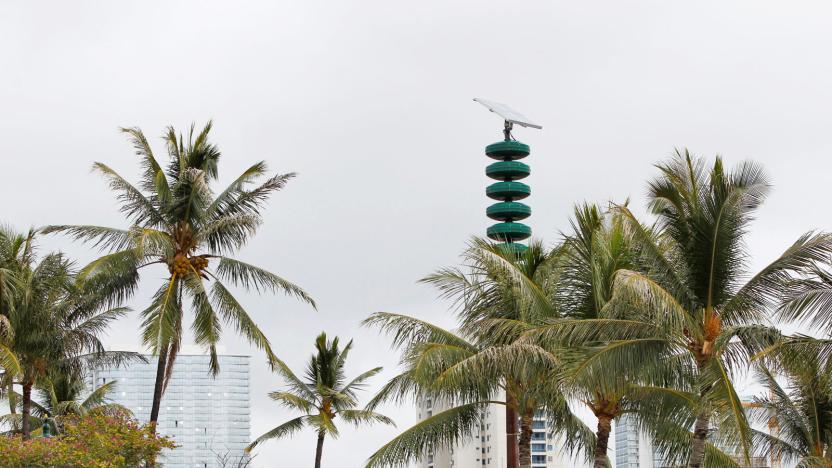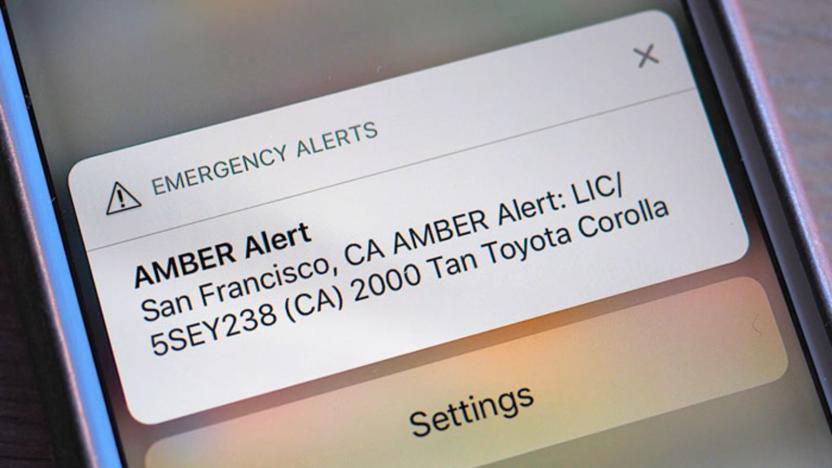EmergencyAlertSystem
Latest

FEMA will test mobile 'Presidential Alert' on September 20th
Don't be surprised if your phone (and everybody else's) goes into a panic in the near future -- that's on purpose. FEMA and the FCC are conducting a national test of both the Emergency Alert System and Wireless Emergency Alerts on September 20th starting at 2:18PM Eastern. If you're included in the test, your device will receive a tone and a "Presidential Alert" warning that makes clear this is just a dry run. You can't opt out, and if circumstances make it inappropriate to send an alert, the test will be postponed to October 3rd.

Senate bill could bring emergency alerts to streaming services
You knew it was only a matter of time before legislators pressed for additional reforms to prevent another false missile alert like the one that rattled Hawaii. US Senators Brian Schatz and John Thune have introduced a bill, the READI Act (Reliable Emergency Alert Distribution Improvement), that would both reduce the chances of mistaken alerts and explore ways to bring those alerts to more people. It would "compel" FEMA to create best practices for emergency alert systems, encourage states to review their systems and create a false alert reporting method, but its most notable inclusion is the possibility of receiving alerts in more places -- including streaming services.

Hawaii officials fire officer who triggered false missile alarm
On January 13th, an officer of the Hawaii Emergency Management Agency (HI-EMA) triggered a missile alert that plunged residents statewide into temporary chaos before the alarm was called off as a mistake. While news emerged yesterday that the employee actually believed the attack was real after misinterpreting a message, and therefore didn't trip the alarm in error, that wasn't a good enough reason to panic the nation. The officer has been fired and the emergency management leader responsible for the agency, Vern Miyagi, has resigned.

FCC: Officer behind Hawaii false missile alert thought it was real
The FCC has published the preliminary findings of its investigation into Hawaii's false missile alert, and it suggests that the story didn't play out as you might have heard. Where initial reports claimed the Hawaii Emergency Management Agency officer who triggered the mass panic clicked on the real alert by mistake, the FCC said the officer fully intended to click it -- because they'd misinterpeted a mangled message. Reportedly, the midnight shift supervisor had played a standard recording that included both the usual "exercise, exercise, exercise" language and the text from a real Emergency Alert System message, which includes "this is not a drill." Although other officers saw this was a drill, the one who clicked the alert was convinced it was real.

FCC investigates Hawaii's false missile alert
It's not just state officials who are investigating Hawaii's false alarm over a (thankfully non-existent) missile attack. FCC Chairman Ajit Pai has confirmed that the regulator's investigation into the error is "well underway." While Pai shied away from making many definitive statements early on, he said that early findings suggested Hawaii didn't have "reasonable safeguards or process controls" to prevent a mistaken alert.

False alarm: Emergency alert in Hawaii claims 'missile inbound'
A few minutes ago, phones across Hawaii received the above emergency alert about a "ballistic missile threat inbound," but according to state officials, it isn't true. US Rep. Tulsi Gabbard, Hawaii's governor David Ige and the state's Hawaii Emergency Management Agency all chimed in on Twitter to confirm the alert is false. It took 38 minutes before a second alert reached phones, confirming that the first one was a mistake. Honolulu police confirmed in a post that "State Warning Point has issued a Missile Alert in ERROR!," while Buzzfeed reporter Amber Jamieson tweets that one EMA employee said it was a part of a drill. US Senator from Hawaii Brian Schatz said the "inexcusable" alert "was a false alarm based on a human error" while the National Weather Service called it a "test message."

FCC chairman wants mobile alerts to be more locally targeted
Today, FCC Chairman Ajit Pai proposed a few changes to the Wireless Emergency Alert system aimed at making it more useful and functional for local officials. While the details of the proposal won't be released until tomorrow, Pai noted a major change is a requirement for wireless carriers participating in the alert program to more precisely target alerts to a particular area rather than distribute them widely. "Emergency officials across America have told the FCC how important it is to better pinpoint these alerts to impacted communities," Pai said. "This would encourage more local officials to use these alerts during emergencies as well as lead Americans to take more seriously the alerts they receive on their mobile devices."

Japan's disaster alerts will work with all Android 8.1 phones
Japan gets a lot of natural disasters. Combine the threat of earthquakes, tsunamis and typhoons (however mild), and it's easy to see why the Japanese government offers alerts across TV, radio and your mobile phone. Those smartphone alerts were usually baked in by carriers, which means if you had an unlocked phone, or a phone that's running on one of several MVNO phone carriers, you would miss out on the potentially lifesaving heads-up.

FCC proposes ‘Blue Alert’ for threats against law enforcement
During their June Open Meeting today, the FCC adopted a proposal to add an alert to the US Emergency Alert System. If enacted, the Blue Alert would notify the public of ongoing threats to law enforcement in their area through broadcast, cable, satellite and wireline video outlets.

FEMA and National Weather Service launch Wireless Emergency Alert System
While it's a little later than expected, the free SMS emergency notification system has now gone live. Wireless Emergency Alert (WEA) messages will be delivered to cell towers in affected areas, which will then broadcast them to all compatible devices in their range. While the system is looking to cover over 97 percent of the country, it's being gradually rolled out across carriers. Sprint and Verizon are both apparently ready for action and while we haven't heard about the status of T-Mobile or AT&T, the National Weather Service has stated that hundreds of smaller carriers haven't yet enabled the broadcasts. However, not all phones -- especially the more elderly bricks still in circulation -- will work with the system. To check whether your weighty cellular still passes muster, hit up the compatible device list at the CTIA link below.

Wireless Emergency Alert system goes live this month, delivers location-based SMS warnings
Last we heard of the federal government's Wireless Emergency Alert system, only Sprint had signed on to deliver the SMS warnings. Now, with the secured participation of all four major carriers and smaller regional operators, that gratis service is set to go live this month, covering nearly 97 percent of active mobile users. Using a "point-to-multipoint system" that targets at-risk subscribers, the National Weather Service, FEMA, FCC and Department of Homeland Security-backed initiative works by sending location-based messages of 90 characters or less to nearby handsets in the event of an imminent meteorological threat. The mostly opt-out service will also accommodate AMBER and Presidential alerts, although you won't have that flexibility for missives sent from our head of state. So, the next time your phone gives off a strange auditory tone, you'll know to head for shelter.

Sprint plans Emergency Alert messaging system in New York City, claims this is only a test
Know those emergency alerts that always seem to crop up when your sports team of choice is about to score a crucial goal? Yeah, well they're headed to a Sprint phone near you, signature auditory tone and all. After successfully testing the service in San Diego last fall, the carrier's gearing up for round two of the FCC and Mayor Bloomberg-approved system in New York City later this year, issuing FEMA alerts from the President, National Weather Service and local emergency operators to over a dozen compliant Android phones. If you're sporting a compatible handset, you can opt-in for the service by either dialing ##CMAS## or selecting the appropriate settings prompt, after which you'll receive geographically-specific texts of up to 90 characters. And don't worry about dismissing these warning messages as any 'ol SMS or racking up additional fees, they'll arrive free-of-charge bearing a unique "vibration cadence" and inbox icon. Curious to see if your phone's made the cut? The skip on past the break for the official PR.

PSA: FEMA to test nationwide Emergency Alert System today, emphasis on 'test'
Don't freak out or anything, but at 2 PM EST today, the US government will sound a nationwide alarm. Barring a coincidence of cataclysmic proportion, however, it will only be a test. It's all part of FEMA and the FCC's Emergency Alert System (EAS), which is slated to be tried out on a nationwide level for the very first time. If, like us, you've spent a healthy portion of your life sitting in front of the TV, you're probably familiar with those monthly local alerts that tend to flash across the screen smack dab in the middle of a Saved by the Bell rerun. That's basically what's gonna happen today across the nation's television and radio networks. Some TV viewers will hear that familiar "this is a test" message during the trial, though most will simply see the word "test" run across their screens. The EAS would allow the president to disseminate information to the public in times of real emergency, which is why the government is so eager to make sure it actually works. All told, it'll last about 30 seconds, so plan your End of the World party accordingly. For more details, hit up the source links below.

PLAN emergency alert system going mobile in NYC and DC this year, nationwide in 2012
If you live in the U.S., you've probably seen those anger-inducing emergency alert system test messages that interrupt your favorite programming on a weekly basis. Most of us have never seen the system used in an actual emergency, but come later this year, cell phone users in New York and Washington will have similar alerts pushed to their mobile devices -- presumably without the annoying weekly tests. Known as PLAN (Personal Localized Alerting Network), the free service will reportedly only work with smartphones (we're guessing the GPS comes into play here) on AT&T&T, Sprint and Verizon. The secure messaging network will likely display messages as notifications, rather than texts, and will push to all compatible devices within an affected area based on the phone's physical location, not just its mobile number. Local, state and federal officials will send notifications in response to disasters and other public safety threats, presidential announcements, and Amber Alerts. In other words: it'll only be used for actual emergencies, so don't expect updates on the whereabouts of your favorite captive reptile.







